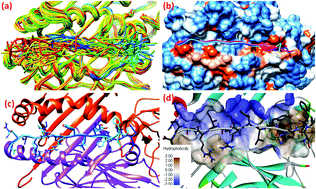当前位置:
X-MOL 学术
›
Mol. Biosyst.
›
论文详情
Our official English website, www.x-mol.net, welcomes your
feedback! (Note: you will need to create a separate account there.)
An immunoinformatics approach to promiscuous peptide design for the Plasmodium falciparum erythrocyte membrane protein-1
Molecular BioSystems Pub Date : 2017-08-11 00:00:00 , DOI: 10.1039/c7mb00332c Nazam Khan 1, 2, 3, 4 , Rajender Kumar 4, 5, 6, 7 , Shakti Chauhan 1, 2, 3, 4 , Umar Farooq 1, 2, 3, 4
Molecular BioSystems Pub Date : 2017-08-11 00:00:00 , DOI: 10.1039/c7mb00332c Nazam Khan 1, 2, 3, 4 , Rajender Kumar 4, 5, 6, 7 , Shakti Chauhan 1, 2, 3, 4 , Umar Farooq 1, 2, 3, 4
Affiliation

|
Plasmodium falciparum erythrocyte membrane protein-1 (Pfemp-1), a variant adhesion molecule, can act as a key component of immunity against malaria. In the current selection of malaria vaccines, no efficient vaccines are available that can be employed for its proper treatment. Unfortunately, resistance to post-infection treatments is increasing and therefore there is a pressing need to develop an efficient vaccine. Peptide-based vaccines can be effective tools against malaria but HLA restriction is a major hindrance which can be conquered by using promiscuous peptides. In this work, we employed a combined in silico and experimental approach to identify promiscuous peptides for the treatment of malaria. At first, using the immunoinformatics approach, promiscuous peptides were predicted from two conserved domains, CIDR-1 and DBL-3γ, of the Pfemp-1 antigen. These peptides were selected on the basis of their predicted binding affinity with different HLA class-I & class-II alleles. A total of 13 peptides were selected based on their predicted IFN-γ and IL-4 induction ability as well as their hydrophobicity. Out of these 13, the peptide C6 was synthesised and experimentally evaluated for further rationalization, HLA–peptide complex modelling and binding interaction analysis. Interestingly, the peptide C6 (SFIHIYLYRNIRIQL) showed an encouraging immunological response and T-cell proliferation in the immunological assay. This valuable content can aid the better design of more potent and selective vaccine candidates against infectious diseases.
中文翻译:

恶性疟原虫红细胞膜蛋白-1混杂肽设计的免疫信息学方法
恶性疟原虫红细胞膜蛋白1(Pfemp-1)是一种变异的粘附分子,可以作为抵抗疟疾免疫力的关键组成部分。在当前选择的疟疾疫苗中,没有有效的疫苗可用于其适当的治疗。不幸的是,对感染后治疗的抵抗力正在增加,因此迫切需要开发有效的疫苗。基于肽的疫苗可能是抗击疟疾的有效工具,但限制HLA是一个主要障碍,可以通过使用混杂肽来克服。在这项工作中,我们采用了组合式计算机技术鉴定用于治疗疟疾的混杂肽的实验方法。首先,使用免疫信息学方法,从Pfemp-1的两个保守域CIDR-1和DBL-3γ预测混杂肽抗原。根据它们与不同的HLA I类和II类等位基因的预测结合亲和力选择这些肽。根据预测的IFN-γ和IL-4诱导能力以及疏水性,总共选择了13种肽。在这13种肽中,合成了C6肽,并进行了实验评估以进一步合理化,HLA-肽复合物建模和结合相互作用分析。有趣的是,肽C6(SFIHIYLYRNIRIQL)在免疫测定中显示出令人鼓舞的免疫反应和T细胞增殖。这种有价值的内容可以帮助更好地设计更有效和更具选择性的抗传染病疫苗。
更新日期:2017-08-31
中文翻译:

恶性疟原虫红细胞膜蛋白-1混杂肽设计的免疫信息学方法
恶性疟原虫红细胞膜蛋白1(Pfemp-1)是一种变异的粘附分子,可以作为抵抗疟疾免疫力的关键组成部分。在当前选择的疟疾疫苗中,没有有效的疫苗可用于其适当的治疗。不幸的是,对感染后治疗的抵抗力正在增加,因此迫切需要开发有效的疫苗。基于肽的疫苗可能是抗击疟疾的有效工具,但限制HLA是一个主要障碍,可以通过使用混杂肽来克服。在这项工作中,我们采用了组合式计算机技术鉴定用于治疗疟疾的混杂肽的实验方法。首先,使用免疫信息学方法,从Pfemp-1的两个保守域CIDR-1和DBL-3γ预测混杂肽抗原。根据它们与不同的HLA I类和II类等位基因的预测结合亲和力选择这些肽。根据预测的IFN-γ和IL-4诱导能力以及疏水性,总共选择了13种肽。在这13种肽中,合成了C6肽,并进行了实验评估以进一步合理化,HLA-肽复合物建模和结合相互作用分析。有趣的是,肽C6(SFIHIYLYRNIRIQL)在免疫测定中显示出令人鼓舞的免疫反应和T细胞增殖。这种有价值的内容可以帮助更好地设计更有效和更具选择性的抗传染病疫苗。











































 京公网安备 11010802027423号
京公网安备 11010802027423号